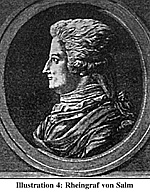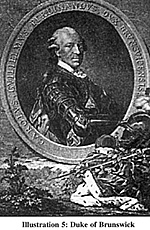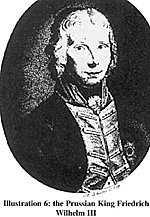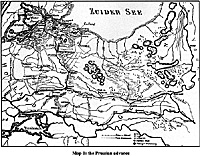The Dutch During
The Revolutionary Wars
Prussian Campaign
in Holland 1787
Part I
Defenses of Holland
by Geert van Uythoven, The Netherlands
| |
The Defences of the Province HollandThe regular army was divided. Although paid and in service of the provinces, many saw the stadtholder William V as the sovereign, and took his side. About 3,500 or 4,000 of them gathered at the cities Amersfoort and Zeist, forming an Orangist field army of 10 infantry battalions and 6 squadrons. The artillery was weak, with only 12, later 15 guns, and of no use, because there were no horses or gunners to serve them. The cities of Wijk-bij-Duurstede and Kuilenburg were occupied by Orangist troops. Also part of the Swiss troops in Dutch service took the side of the stadtholder. Units identified as taking part on the Orangist side are:
Regiment Oranje-Nassau No. 1 Regiment No. 6 van Welderen Regiment No. 11 van Efferen (3 October 1787:'van Dam') Regiment No. 13 Baden-Durlach Regiment No. 14 Hessen-Darmstadt Regiment No. 16 van Mönster Regiment Zwitsers May No. 5 (Swiss) Regiment Gardedragonders (2 squadrons) Regiment van Tuyll van Serooskerken (cuirassiers, 2 squadrons) Regiment van der Hoop (cuirassiers, 2 squadrons) About as many units stayed in the 'generaliteitslanden' (Brabant and Limburg) and stayed neutral throughout the Prussian campaign. 11 infantry regiments, three cavalry regiments, and part of the artillery (over 8,000 men) took part on the patriots side. Identified units are:
Regiment No. 2 Meyer [9] Col Georg Christiaan Meyer Regiment No. 5 Pallardy Regiment No. 7 van Hardenbroek 2 bats Regiment No. 8 Onderwater Regiment No. 12 van Bylandt 1 bat? Regiment No. 18 von Pabst Regiment No. 23 Stuart Regiment No. 24 Dundas Regiment Saxen-Gotha Regiment Walen van Grenier [10] (Walloon) 2 bats Col G. van de Pol Col. M.E.H. van Citters Regiment Sternbach [11] Lt-Col Sternbach Regiment Huzaren van Salm 4 sq Lt-Col Baron C.E. van Düring Regiment Dragonders van Bylandt The Orangist troops lacked nearly everything, and were not capable of undertaking any offensive actions on their own. Nevertheless, the patriots could not ignore these troops. The patriots were confident that the French would support them. In fact, about a hundred artillerymen, in civilian clothing, would form all the help the patriots would receive from France, beside some engineers and artillery-officers.
Because of the above, the patriots could only rely on about 20,000 men, augmented by auxiliaries and militia to maybe 40,000 at the most. The few regular troops who stayed with the patriots proved to be unreliable and demoralised. As described, commander of the 'field army' became the German Friedrich (II) Johann Otto, Rheingraf von Salm-Salm Kyrburg [12]. The French Chevalier de Ternant was appointed as Lieutenant General of the cavalry. Lieut-Gen van Rijssel became General-Lieut-enant-Captain of the infantry, and received command of the defences along the rivers Vaart and Vecht. Von Salm divided his troops into at least 16 'regiments'. Information on these troops is very scarce, but the following units are identified:
In addition, some (weak) patriot cavalry units were present:
There was plenty of artillery, especially to defend the fortresses and cities. Dutch gunners were scarce, but augmented by the experienced French 'volunteers'.
The defence would be directed by a 'Defence-Commission' at Woerden. The patriots decided to defend what was known as the third defence line, because the other two lines were much further east, with many Orangist troops and an unreliable population already west of them. The third defence line was from the fortress-city Muiden along the river Vecht to the city Utrecht, and from there along a canal (Vaart) to the village Vreeswijk at the river Lek, and from there south to the fortress-city Gorkum at the river Waal. At Utrecht, the Rheingraf von Salm would take up a central position with the field army, to advance to any threatened point of the defence line. 1,200 men garrisoned Gorkum. To strengthen the defences further, frigates and gunboats took up position on the rivers and canals, to add their fire to that of the land defences.
In August, the Prussians started massing troops in the Duchy of Cleve, to reinforce the Prussian claim for satisfaction. Still the States of Holland did not give way. On 8th September a Prussian ultimatum followed: the Prussians would attack the province Holland if their States did not give satisfaction, punish the guilty ones, and give Princess Wilhelmina free passage. Again, the States of Holland refused. On 13 September, the Prussians crossed the Dutch border. The Prussian order of battle was as follows:
Notes: - Total strength: 26,000, including the artillery train.
Originally an infantry regiment consisted of 2 battalions, each of a grenadier-company and 5 musketeer companies. On 1 June 1787, these regiments were reorganised. A grenadier battalion was created, by combining both grenadier companies with a musketeer-company of each battalion. The result was a regiment of 3 battalion's -a grenadier-battalion and 2 musketeer-battalions- with 4 companies each. The grenadier-battalions were not only to be used as an elite, but preferably as light infantry, the same way as the green-clad fusiliers were used.
The cuirassiers had no armour, and were used in a light cavalry role. Graf (count) von Kalkreuth stated: "I do not need hussars: what they can, we can ourselves!". He would prove this statement in the upcoming campaign. Von Kalkreuth had his own ideas also on other matters. Although only foot artillery was present, he felt the need that great that he created his own horse artillery, with two 3pdr guns taken at Nieuwersluis, served by cuirassiers under the command of Lieutenant von Leschinski, to accompany the Kürassier Regiment von Kalkreuth.
The foot artillery was commanded by Major Geelhaar and consisted of 4 batteries with heavy 6pdr guns, 6x 10pdr howitzer and 418 men. The gunners came from the 2nd and 3rd Regiment Artillery.
42x regimental 3pdr guns, operated by 371 gunners of the artillery, were also present.
Total strength of the jäger was 400 men, under the overall command of Major von Valentini.
The 1st musketeer battalion from the Rgt von Natalis was used to garrison the German city Minden during the campaign, while the fusilier battalions Von Beauvray and Von Salenmon garrisoned the city Wesel.
The Prussians made it very clear that they only fought against the province Holland, and not against the other provinces and the 'generaliteitslanden'.
Only the States of Overijsel objected, and Brunswick responded by sending the 2nd battalion (5 squadrons) of the Husaren-Regiment Graf Golz No. 8 under the command of Lt-Col von Goecking, to this province. They arrived on 18 September at Ootmarsum, from where many patrols traversed the province, and their presence was enough to prevent interference with the Prussian advance. The cities Zutphen and Deventer were occupied, the latter by a squadron commanded by Major von Blücher. Von Goecking occupied the major city of Overijsel, Zwolle, with 3 squadrons. The Prussians seized about 10,000 muskets from the patriots.
Before the hostilities started the Prussians openly reconnoitred, making contact with Orangists. They tried to deceive the patriots in believing that they would advance straight to Amsterdam in the direction of the fortress-city Naarden, by way of the high ground between the great rivers and the Zuiderzee, without fortresses. Anyone was able to see the assembled troops at the Duchy of Cleve with his own eyes. The fact that there were no siege train and brass pontoons further reinforced this thought. The consequence of this was that the patriots failed to inundate much terrain to reinforce their defences. Brunswick took in account a probable intervention by French troops, reason why he kept north of the rivers Meuse and Waal [16]. The need to cross these rivers, and the fact that the fortresses and cities in Brabant were occupied by Orangist troops who at least could slow the French down, would give the Prussians enough time to react in case of any French advance [17].
To reach the province Holland, the Prussians would encounter three Dutch defence lines. The first line was at the river IJssel, and could not bar the advance of the Prussians, because the Orangist army at Zeist was already west of this line. These troops were also west of the second defence line, along the rivers Eem and Grebbe, but a strong attack from the Rheingraf von Salm could throw the Orangists back across line before the Prussians could interfere. The strongest barrier would be the third line, from the fortress-city Muiden along the river Vecht to the city Utrecht, and from there along a canal (Vaart) to the village Vreeswijk at the river Lek, and from there south to the fortress-city Gorkum at the river Waal. Gorkum lies also at the border of the province Gelre, and to protect Gelre against an attack, 200 'Orangist' Swiss of the Regiment May, commanded by Captain Gabriel Adriaan de Gross, entrenched themselves in the village Dalem.
Brunswick decided to attack this line near the village Vreeswijk. At this place, the river Lek would cover his left flank, while he was far enough from Utrecht, were the patriot field army was concentrated. Further, the defence lines behind the river Vecht would be very difficult to break because of its natural strength. If he were to attack Utrecht, he would have to face most of the patriot troops. Further, this would complicate matters, because Utrecht was –naturally- in the province Utrecht. Attacks on Vreeswijk and Gorkum would give no diplomatic difficulties, because these cities were situated in the province Holland. The capture of Gorkum was important, to prevent a French advance and interference with the Prussian plans.
The three divisions would follow separate routes (see map):
1st Division (Lieut-Gen Graf von Lottum)
Von Lottum's task was to pin down the patriots by advancing along the way the patriots had to believe the Prussians were coming. They would cross the river IJssel at Westervoort, and advance on the city Arnhem and from here to Naarden by way of Barneveld, Amersfoort, and Hilversum, and keep the patriots busy by feint attacks. If the remaining Prussians Divisions could force the defence line, Von Lottum had to take every opportunity to attack also. He was not to co-operate with the stadtholder, because it was meant to leave these troops out of the fight, but in case of trouble, he could count on his help. Of his force, 150 cavalry and 200 infantry had to patrol along the river IJssel, to give warning in time against an attack from that side. Although Lieut-Gen von Lottum commanded this Division, we will see that Maj-Gen von Kalkreuth, who was attached to this Division, initiated and undertook nearly all the actions on his own account, operating in person with the most forward troops, not in any way checked by Von Lottum.
2nd Division (Lieut-Gen von Gaudi)
The 2nd Division would follow the first Division to Arnhem. There the Division would be divided. The Advance Guard and Main Force had to advance south of the rivers Rhine and Lek, by way of Heusden, Kuilenburg, and Everdingen. Then it had to take the cities Vianen and Vreeswijk, assisted by the 3rd Division. The 'Brigade' Woldeck had to advance north of the same rivers, by way of Wageningen 18 and Wijk-bij-Duurstede. These three battalions then had to attack the defence line along the Vaart near Vreeswijk frontally, while the remainder of the 2nd Division would turn their flank across the river Lek.
3rd Division (Lieut-Gen von Knobelsdorff)
The 3rd Division would move to the city Nijmegen, and at that place cross the river Waal. It then had to advance along the north bank of the river Waal to the west, by way of Ochten, Tiel and Thuil. The advance guard would have the important task to take the fortress-city Gorkum, and would have to move on this city as quickly as possible. The main force had to assist the 2nd Division in taking Vianen.
After the taking of the defence line Gorkum – Vianen – Vreeswijk – Utrecht – Muiden, according to the situation, the Duke of Brunswick would make new plans to follow up the initial results.
The Duke of Brunswick planned to use the many waterways for supplying his troops. To do this, he utilised many ships, of which about 50 were specially build for the campaign. Eight of these were organised as hospital ships, and a ninth supplied with medicaments, in order that wounded soldiers could be treated very quickly and very well. Because of this, many wounded recovered and could return to duty after a very short stay on the hospital ships. To treat the badly wounded, a big field hospital was furnished at the German city Wesel. 40 big and 10 smaller ships were to be used to ferry troops across waterways, or to form pontoon bridges. Beside these, boats were hired to supply the troops the first days of their march into the Dutch Republic.
The Duke of Brunswick was a very precise man. All the orders, about every detail of the campaign, he wrote with his own hand. This was something, which was not appreciated by his subordinates, who felt they were not trusted.
Illustration 6: the Prussian King Friedrich Wilhelm III
Next issue: The opening of the campaign
The maps are taken from the works of: An., "Nauwkeurig historiesch verhaal…", Von Pfau, "Geschichte des Preuszischen Feldzuges…", Senckler, "Der Preuszische Feldzug…" and Vervat, "De Pruisen voor Amsterdam…".
[1] Hereafter called 'Dutch Republic'
More Prussian Campaign in Holland 1787 Part I
The Dutch During the Revolutionary Wars
|
 At right: Illustration 4: Rheingraf von Salm
At right: Illustration 4: Rheingraf von Salm
 At right: Illustration 5: Princess WilhelminaOn 7 August, the Duke of Brunswick arrived at Nijmegen, where William V resided. His arrival coincided with the birthday of Princess Wilhelmina, so his presence did not raise suspicion with the patriots. The duke kept in close contact with the Princess to gain as much intelligence as possible on the Dutch Republic, while the stadtholder moved to the troops that had chosen his side and were gathering at Zeist. Prussian staff-officers were sent to the States of Gelre, Utrecht, and Overijsel, to assure them that the Prussians did not come to fight them but only the province Holland, and too ask free passage.
At right: Illustration 5: Princess WilhelminaOn 7 August, the Duke of Brunswick arrived at Nijmegen, where William V resided. His arrival coincided with the birthday of Princess Wilhelmina, so his presence did not raise suspicion with the patriots. The duke kept in close contact with the Princess to gain as much intelligence as possible on the Dutch Republic, while the stadtholder moved to the troops that had chosen his side and were gathering at Zeist. Prussian staff-officers were sent to the States of Gelre, Utrecht, and Overijsel, to assure them that the Prussians did not come to fight them but only the province Holland, and too ask free passage.
 At right: Illustration 6: King Friedrich Wilhelm III
At right: Illustration 6: King Friedrich Wilhelm III
